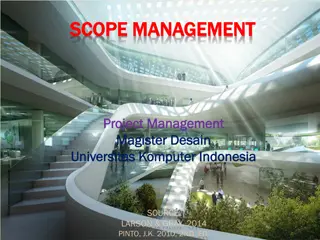Research Methods and Project Management
Explore the importance of validity in research studies, discussing threats to validity such as construct, internal, and external validity. Learn about Prof. Ioannidis' work on the reliability of scientific studies and guidelines for case study research in software engineering. Discover examples of threats to validity and the impact of external factors on research outcomes.
Download Presentation

Please find below an Image/Link to download the presentation.
The content on the website is provided AS IS for your information and personal use only. It may not be sold, licensed, or shared on other websites without obtaining consent from the author.If you encounter any issues during the download, it is possible that the publisher has removed the file from their server.
You are allowed to download the files provided on this website for personal or commercial use, subject to the condition that they are used lawfully. All files are the property of their respective owners.
The content on the website is provided AS IS for your information and personal use only. It may not be sold, licensed, or shared on other websites without obtaining consent from the author.
E N D
Presentation Transcript
Research Methods and Project Management Lecture 5a Threads to validity of a study M. Tsiknakis Postgraduate Course on Informatics Engineering , Fall 2023
Validity of a study Can you trust the results of your study? Why? What are the measures? What are the threats (mistakes)? Experiment objective Experiment operation 1. Conclusion validity 2. Internal validity 3. Construct validity 4. External validity
Validity of Research Due to the large influence that external factors have on researchers and their studies, Prof Ioannidis has dedicated much of his career to exposing the unreliability of scientific studies. He declared that much of what biomedical researchers conclude in published studies - conclusions that doctors keep in mind when they prescribe antibiotics or blood-pressure medication, or when they advise us to consume more fiber or less meat, or when they recommend surgery for heart disease or back pain - is misleading, exaggerated, and often flat-out wrong. He charges that as much as 90 % of the published medical information that doctors rely on is flawed. * Ioannidis, J. Why Most Published Research Findings are False. PLoS Medicine. 2.8 (2005), Accessed on 29 October 2018.
Validity of Research see : John Ioannidis: "Reproducible Research: True or False?" | Talks at Google https://www.youtube.com/watch ?v=GPYzY9I78CI John P.A. Ioannidis, MD, DSc, is a Professor of Medicine, Health Research and Policy, and Statistics at Stanford University. He is also the founding Director of the just-launched Meta- Research Innovation Center at Stanford (METRICS)
Threats to validity (Case Studies) Source: Runeson, P. and H st, M. 2009. Guidelines for conducting and reporting case study research in software engineering. 1. Construct validity Do the operational measures actually reflect what the researcher had in mind ? 2. Internal validity Are there any other factors that may affect the results ? Mainly when investigating causality ! 3. External validity To what extent can the findings be generalized ? Precise research question & units of analysis required 4. Reliability To what extent is the data and the analysis dependent on the researcher (the instruments, ) Other categories have been proposed as well credibility, transferability, dependability, confirmability
Threats to validity Examples (1/2) 1. Construct validity Do the operational measures reflect what the researcher had in mind ? (Are we measuring what we believe that we are measuring?) Time recorded vs. time spent Execution time, memory consumption, + noise of operating system, sampling method Participants in interviews have pressure to answer positively. 2. Internal validity Are there any other factors that may affect the results ? Were phenomena are observed under special conditions + in the lab, close to a deadline, + major turnover in team, contributors changed (open-source), Similar observations repeated over time (learning effects).
Construct validity This aspect of validity reflects to what extent the operational measures that are studied really represent what the researchers have in mind and what is investigated according to the research questions. If, for example, the constructs discussed in an interview questions are not interpreted in the same way by the researcher and the interviewed persons, there is a threat to the construct validity. This is why questionnaires before been used are validated
Internal validity This aspect of validity is of concern when causal relations are examined. When the researcher is investigating whether one factor affects an investigated factor there is a risk that the investigated factor is also affected by a third factor. If the researcher is not aware of the third factor and/or does not know to what extent it affects the investigated factor, there is a threat to the internal validity. E.g. relation of link capacity to humidity Need to keep temperature (the third factor/variable) constant
Threats to validity Examples (2/2) 3. External validity To what extent can the findings be generalized ? Does it apply to other languages ? other sizes ? other domains ? Background & education of participants Simplicity & scale of the team + small teams & flexible roles vs. large organizations & fixed roles 4. Reliability To what extent is the data and the analysis dependent on the researcher (the instruments, )? How did you cope with bugs in the tool, the instrument ? Classification: if others were to classify, would they obtain the same ?
External validity This aspect of validity is concerned with to what extent it is possible to generalize the findings, and to what extent the findings are of interest to other people outside the investigated case. During analysis of external validity, the researcher tries to analyze to what extent the findings are of relevance for other cases. There is no population from which a statistically representative sample has been drawn. However, for case studies, the intention is to enable analytical generalization where the results are extended to cases which have common characteristics and hence for which the findings are relevant, i.e. defining a theory.
Reliability This aspect is concerned with: to what extent the data and the analysis are dependent on the specific researchers? Hypothetically, if another researcher later on conducted the same study, the result should be the same. Threats to this aspect of validity is, for example, if it is not clear how to code collected data or if questionnaires or interview questions are unclear.
Conclusion The case study methodology is well suited for many kinds of software engineering research, as the objects of study are contemporary phenomena, that are hard to study in isolation. Case studies do not generate the same results on e.g. causal relationships as controlled experiments do, but they provide deeper understanding of the phenomena under study. As they are different from analytical and controlled empirical studies, case studies have been criticized for being of less value, impossible to generalize from, being biased by researchers, etc This critique can be met by applying proper research methodology practices as well as reconsidering that knowledge is more than statistical significance.
Internal and External Validity in Experimental Research Suggest to listen the following presentations on YouTube regarding VALIDITY of Experimental Research https://www.youtube.com/watch?v=Hd7GTlQ7SXs (Types of validity) https://www.youtube.com/watch?v=FOnPrhGygg0&t=135s (Forms of Validity in Research and Statistics) https://www.youtube.com/watch?v=Ak7eQMJd6J8 https://www.youtube.com/watch?v=mZafK0VPpeY
Internal and External Validity in Experimental Research Listen the following presentation on YouTube Reliability, validity, generalizability and credibility. Pt .1 of 3: Research Quality https://www.youtube.com/watch?v=4NQHeI8GD54 Research Review: 7 - Internal and external validity; Summary of research methods https://www.youtube.com/watch?v=Ak7eQMJd6J8
Homework Write a short assay to discuss a) The criticism for Case Studies as being of less value, and impossible to generalize from and b) The threads to validity of experimental research (and Case studies), i.e. Construct validity, internal validity, external validity and reliability (seek to identify examples for each of the thread) Seek to identify relevant literature for your HW

























![Project Initiation Document for [Insert.Project.name] [Insert.Project.number]](/thumb/226757/project-initiation-document-for-insert-project-name-insert-project-number.jpg)
